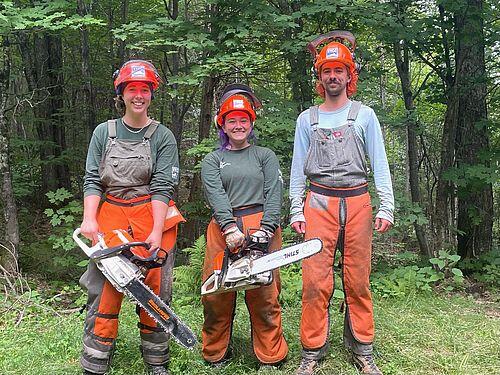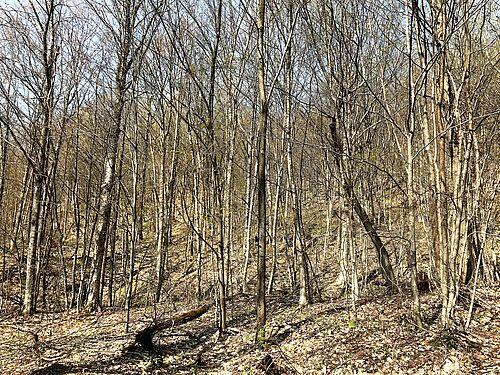This article was written and published by Cold Hollow to Canada's Monica Przyperhart.
Learn more about Cold Hollow to Canada: https://www.coldhollowtocanada.org/
Bird habitat. A sugarbush. Young people with chainsaws. Do these three things fit together?
You bet! And Cold Hollow to Canada is happy to be working alongside all three in the woods of Belvidere.
If you’ve been following Cold Hollow to Canada (CHC), you likely know about our Woodlots Program. We work with groups of landowners to provide resources, assistance, and a peer network that together engage landowners who want to incorporate wildlife habitat, climate resilience, and overall forest health into the management of their forests.

Audubon Vermont has been a long-standing partner in this program. Through their Healthy Forests Initiative, Audubon staff have been in the woods with most Woodlots landowners to survey the forest through the eyes of Vermont’s birds. What features do each parcel have that provide existing habitat–and for what birds? Are there ways habitat could be enhanced? What’s missing across the larger region for birds, and where could missing habitat be developed? These are a few of the questions considered during the process. When working with sugarmakers, Audubon’s program includes an additional option that allows a sugaring operation to use an eye-catching “Bird Friendly Maple” label in their marketing. Many landowners then work with their foresters to integrate recommendations into the next forest management plan update, and CHC can follow up to provide ongoing support and resources. When recommendations are implemented, Woodlots groups often check out and learn from the results, too.
This summer, we’ve added a third partner to the mix, and we think this addition could be a fantastic way to implement Audubon’s habitat recommendations. The partner? Vermont Youth Conservation Corps, or VYCC. VYCC’s Forestry Program trains teens and young adults with forest management skills, then takes them on the road. The teams learn chainsaw use and safety, invasive species removal, tree planting, and a host of other practices that can be used to help with forest management. Because they are working by hand–not a skidder or brontosaurus in sight–these crews can climb steep slopes inappropriate for heavy equipment, and they can hike into areas far from roads. They also limit their work to non-commercial projects, offering a good match for those practices targeting habitat improvements for birds and other wildlife.
In the fall of 2021, Audubon Vermont received a grant from the Sarah DeCoizart Trust, through the Cornell Lab of Ornithology, that allows all three groups to test drive this partnership. Audubon provides the expertise on bird habitat, VYCC provides the labor, and CHC connects the other organizations with a landowner who has a shovel-ready management project. Audubon Vermont has also benefited from the generosity of additional donors such as the Cotyledon Fund, Lookout Foundation, and others who are supporting this collaboration -- all of whom recognize the important synergies of this collaborative effort.
Because of these grants, the project comes at no cost to the landowner. The match we found was Barred Woods Maple, a conserved forest parcel in Belvidere that has been through Audubon’s Bird Friendly Maple program. Owned jointly by a group of six people, the parcel’s management plan prescribes a “crop tree release with canopy gap formation” in an area that will be tapped for maple production for the first time next winter. In other words, thinning will occur around some of the most vigorous trees in the young forest, to open up the crowns of not only sugar maples but a mix of other species as well, to maintain diversity in the sugarbush.

This practice will let the selected trees grow faster, produce more seeds to encourage regeneration, open up light to encourage development of the understory, and create habitat in the process. Because different species of birds forage, nest, and sing from different layers of the forest, avian diversity can be enhanced by increasing the structural complexity of the woods. In our rapidly-changing world, it’s also worth noting that this practice can enhance carbon sequestration and storage to boot.
Effecting change when it comes to forest health that supports the needs of birds and people doesn’t happen overnight. It requires a planned sequence of activities that involve a variety of stakeholders. In the case of the project at Barred Woods Maple, we started with landowners valuing the habitat value of their sugarbush. From this interest, Audubon VT provided technical assistance on how to maximize bird habitat opportunities while still meeting other goals, such as maple sap production. The consulting forester updated a forest management plan with prescriptions to help achieve these dual goals. Now, VYCC is on-site to implement the work on the ground. It’s a great model for the value of partnerships in conservation
- Steve Hagenbuch, Audubon Vermont
When the full team met on the property this spring to scope out the project and plan the work, I asked one landowner, Matt Paggi, “If VYCC weren’t doing this work for you, how would you be getting it done?” I wanted to know if there was a down side. Were we taking work away from a local contractor by offering the job to this youth crew instead?
I needn’t have worried. “The job probably wouldn’t be done at all,” Matt replied. “The value of the cut wood is very low so it’s non-commercial. Contractors in our area are focused on larger jobs so it's very difficult to find someone for a job like this.” Charlie Hancock, the consulting forester for Barred Woods Maple, agreed, confirming that this is often the case for projects of this nature.
As I see it, it’s a win-win-win. Bird habitat is created. Youth get on-the-ground training in a field much in need of skilled professionals. The landowner gets a job done that wouldn’t otherwise be accomplished. Add in the benefits to forest health and climate resilience, and we’ve got ourselves a pretty compelling partnership.
As I write this note, a VYCC crew is camping at Barred Woods Maple. From what I hear, they’re having a great time doing it, too. They’re outside, building community and connecting with great people and a beautiful place. In my eyes, that’s yet another win.



